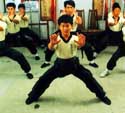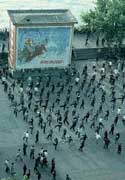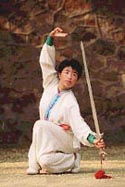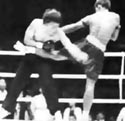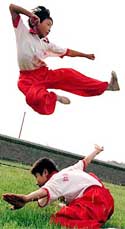
| Home | |||
| About Us | |||
| Overview | |||
| History | |||
| Philosophy | |||
| References | |||
| Shaolin | |||
| Hsing Yi | |||
| Tai Chi | |||
| Bagua | |||
| Baji | |||
| Health | |||
| Other Styles | |||
|
|
|||
| Links | |||
| Directory | |||
| News | |||
rich variety of kung fu styles exists because of the many variations in Chinese culture, geography, philosophies, and physical structures. Each of the ethnic populations residing in the different parts of China has its own form of martial arts. For example, the Muslim minority in the Shandon province is famous for its Cha and Hua quan. The Han majority in the South practices Nan quan or various family styles. People in northern China practice Chuojiao and Tantui. Every practitioner adapts the style to take advantage of their physical and mental attributes. Some schools concentrate on the use of the fists and hand techniques, while others emphasize leg strikes and footwork. Others yet show interest in tricks and complexity, while some prefer simplicity. Martial arts are truly infinite in depth and variety.
The practice of kung fu can be understood in terms of
Classification of the Type of Training
istory and lineage is an important component of kung fu. Part of the importance is due to the influence of Confucian philosophy and its emphasis on the value of the teacher-student relationship. The other aspect of the art is that the value of a particular style should be tested over time.
Each style has a combination of offenses and defense. In addition, there is an integration of the external and the internal: external in terms of movements and physical actions; internal in terms of practice of the mind and chi qong.
Some styles of kung fu use instruments, apparatus and weapons to enhance practice. Other styles stress the use of meditation and static exercises.
Each style of kung fu can also be classified according to one or more of the following components:
1. Solo practice is the basis for kung fu. It includes basic movements, stretching, and various static exercises, whose purpose is to develop the physique of the practitioner, to strengthen the circulation of the chi, and to improve fighting skills.
2. Routines are organized sequences of techniques conceived to aid the practitioner in developing timing and coordinated action.
3. Group practice is a collective event where a group of people practice together barehanded or with weapons. This exercise requires high concentration, skill, and the close cooperation of every participant.
4. Weapons practice.
5. Sparring - Sparring without weapons, armed sparring, sparring between armed and unarmed participants.
6. Duel - Lei Tou (stage fighting - banned since the founding of the Republic), sanshou (free hand), sanda (free fighting), push-hands and weapons fighting.
7. Neigong - Internal exercises.
A student can easily benefit by practicing one or more components of this Martial Arts curriculum. However, this does not mean that a school needs to cover all the components to be effective. A student should be aware of the infinite varieties available in the study of the martial arts.
Practice Objectives for Training
he objectives of kung fu practice vary with the individual and often evolve with time. In general, practitioners seek to benefit in areas of:
1. Moral Growth - Kung fu is conducive to developing good manners and conduct. Deeply influenced by Confucian philosophy, it promotes good moral character, nourishes the spirit and fosters proper temperament.
2. Self defense - Kung fu is about martial arts. Even though armed and unarmed combat are no longer an important part of modern day society, practitioners should appreciate the origins of the art and try to understand the applications for self- defense of the movements they practice. For the few who are interested in the combat aspects of kung fu, the techniques are rich in diversity and effectiveness in terms of attack and defense.
3. Health improvement - Some kung fu styles include exercises that benefit the external and internal parts of the body.
4. Artistic merit - Kung fu forms contain many graceful movements of the body and can be visually appealing. Some elements of kung fu can be found in traditional dance and opera.
5. Coordination - Kung fu practice is about the harmonization of the mind and the body as well as the synchronization of the internal and the external.
Benefits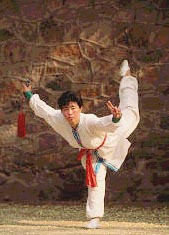
onsistent practice has many benefits including:
The benefits can only be achieved with dedication and consistent practice. In time, to obtain the best results, raining becomes integral aspects of the student's life.
|
"Do
cat stretches .. Meow :-)."
|
Stretching
Your muscles and your joints are link the parts of your body together, and power your body. Strong, supple, and loose muscles and joints are required for maximum health. Anyone who has done any level of physical activity is aware of this. And to anyone who has sweated and worked hard at any physical endeavor, this will seem like pure common sense.
Breathing
Whether nourishing your body with oxygen or eliminating waste gases from your body, your breath is vital to you as a living creature. Breathing techniques are a common practice among various medical, spiritual, and martial traditions, and can be designed, in some cases, to achieve very specific ends.
Standing
Often studied in conjunction with breathing and stretching exercises, standing is a vital component in its own right. Because they allow you to develop a thorough feeling for your own body, standing exercises are the basis for further work. One thing that often surprises newcomers is just how poor their posture is. Along with that realization comes another: just how much of their upper body musculature they tend to use to support themselves. Training your body to have correct posture and to support yourself with minimal effort are two prime goals of initial standing training.
Stances
Your link to the ground. The very foundation of your body's structure. Although there are no stances per se in practice and in movement, do offer positioning and structural checkpoints. During training, practitioners will move through these checkpoints as they step and execute techniques. The different stances have different strengths and weaknesses.
Stepping
Martial arts require training in motion. Once the students learn the basics of stillness, the training of coordinating the various parts of the body can begin. Stepping training enables the practitioner to move fluidly and quickly through the stance checkpoints, increasing one's speed, quickness, and stability. One step at a time, the mind is opened and recaptures the wonderment of movement again. Each style promotes various degrees of weight distribution, but in the end, stepping helps train the mind and the body.
Copyright 2003
